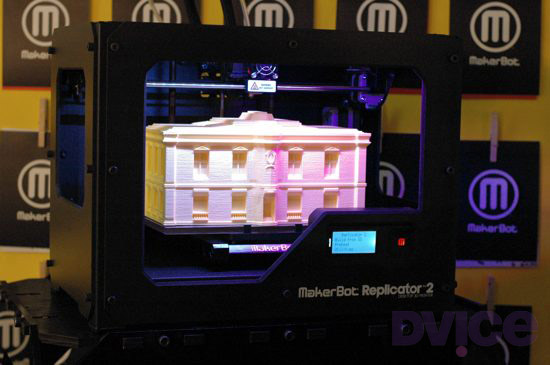The MakerBot Replicator 2 Desktop 3D Printer. (Image Credit: Kevin Hall/DVICE)
The new Replicator 2 looks good on a shelf, but also boasts two
notable upgrades: it's insanely accurate with a 100-micron resolution,
and can build objects 37 percent larger than its predecessor without adding roughly any bulk to its size.
In a small eatery in
Brooklyn, New York, MakerBot CEO Bre Pettis unveiled the next generation
Replicator 2, which he presented in terms of Apple-like evolution in
design. From the memory of its own Apple IIe in much smaller DIY 3D
printing kits comes the all-steel Replicator 2. The fourth generation
MakerBot printer ditches the wood for a sleek hard-body chassis, and is
"designed for the desktop of an engineer, researcher, creative
professional, or anyone who loves to make things," according to the
company.
Of course, MakerBot, which helps enable a robust community of 3D printing enthusiasts,
is all about the idea of 3D printing at home. By calling them desktop
3D printers, MakerBot alludes to 1984's Apple Macintosh, the first
computer designed to be affordable. The Macintosh was introduced at a
fraction of the cost of the Lisa, which came before it and was the first
computer with an easy-to-use graphical interface.
Each iteration of MakerBot's 3D printing technology has tried to find
a sweet spot between utility and affordability. Usually, affordability
comes at the cost of two things: micron-level layer resolutions (the
first Replicator had a 270-micron layer resolution, nearly three times
as thick) and enough area to build. The Replicator 2 prioritizes these
things, and, while it only has a single-color extruder, can still be
sold at an impressive $2,100.
Well, to really be a Macintosh, the Replicator 2 also needs a
user-friendly GUI. To that end, MakerBot is announcing MakerWare, which
will allow users to arrange shapes and resize them on the fly with a
simple program. If you don't need precise sizes, you can just wing it
and build a shape as large as you like in the Replicator 2's
410-cubic-inch build area. More advanced users can set out an array of
parts with the tool across the build space, and print multiple smaller
components at once:

Even with all that going for it, $2,100 isn't a very Macintosh price —
the original Macintosh was far cheaper than the Lisa before it.
MakerBot's 3D printers have gotten more expensive over the years: $750
Cupcake, $1,225 Thing-O-Matic, $1749 Replicator
(which the company still sells), and now a $2,100 Replicator 2. With
that in mind, maybe it's not price that will determine 3D printers
finding a spot in every home, but the layer resolution.
Printing with a 100-micron layer resolution, the amount of material
the Replicator 2 puts down to build an object is impressive. To
illustrate, each layer is 100 microns, or 0.1 millimeters, thick. A
six-inch-tall object, which the printer can manage, would be made of at
least 1,500 layers.
Most importantly, at 100 microns, the objects printed feel smooth,
where the previous generation of home printers created objects that had
rough wavy edges. The Replicator 2 uses a special-to-MakerBot bioplastic
that's made from corn (to quote Pettis: "It smells good, too"), and the
3D-printed sample MakerBot gave us definitely felt smooth with a barely
detectable grain.
The MakerBot Replicator 2 appears on the October (2012, if you're from the future) issue of Wired
magazine with the words, "This machine will change the world." Does
that mean 3D printing affordable, useable, accurate and space-efficient,
yet? If the answer is yes, you can get your own MakerBot Replicator 2 from MakerBot
(One last thing, Pettis urged us all to check out the the brochure
as the MakerBot team "worked really hard on it" to make it the "best
brochure in the universe." Straight from my notes to your screen.)


